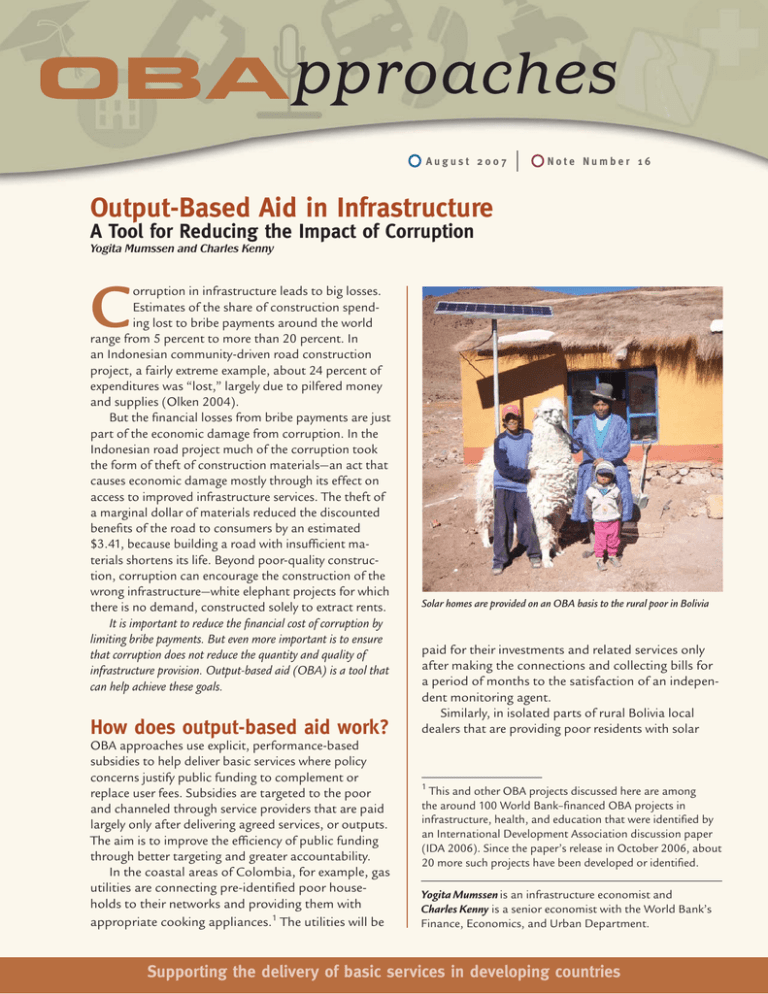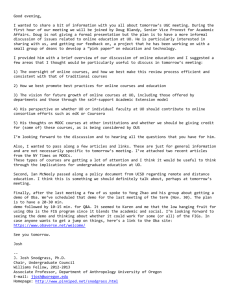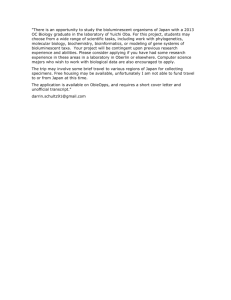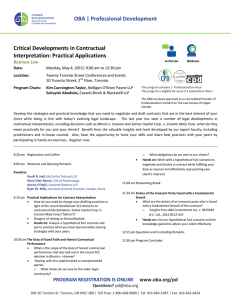C pproaches Output-Based Aid in Infrastructure
advertisement

pproaches August 2007 Note Number 16 Output-Based Aid in Infrastructure A Tool for Reducing the Impact of Corruption Yogita Mumssen and Charles Kenny C orruption in infrastructure leads to big losses. Estimates of the share of construction spending lost to bribe payments around the world range from 5 percent to more than 20 percent. In an Indonesian community-driven road construction project, a fairly extreme example, about 24 percent of expenditures was “lost,” largely due to pilfered money and supplies (Olken 2004). But the financial losses from bribe payments are just part of the economic damage from corruption. In the Indonesian road project much of the corruption took the form of theft of construction materials—an act that causes economic damage mostly through its effect on access to improved infrastructure services. The theft of a marginal dollar of materials reduced the discounted benefits of the road to consumers by an estimated $3.41, because building a road with insufficient materials shortens its life. Beyond poor-quality construction, corruption can encourage the construction of the wrong infrastructure—white elephant projects for which there is no demand, constructed solely to extract rents. It is important to reduce the financial cost of corruption by limiting bribe payments. But even more important is to ensure that corruption does not reduce the quantity and quality of infrastructure provision. Output-based aid (OBA) is a tool that can help achieve these goals. How does output-based aid work? OBA approaches use explicit, performance-based subsidies to help deliver basic services where policy concerns justify public funding to complement or replace user fees. Subsidies are targeted to the poor and channeled through service providers that are paid largely only after delivering agreed services, or outputs. The aim is to improve the efficiency of public funding through better targeting and greater accountability. In the coastal areas of Colombia, for example, gas utilities are connecting pre-identified poor households to their networks and providing them with appropriate cooking appliances.1 The utilities will be Solar homes are provided on an OBA basis to the rural poor in Bolivia paid for their investments and related services only after making the connections and collecting bills for a period of months to the satisfaction of an independent monitoring agent. Similarly, in isolated parts of rural Bolivia local dealers that are providing poor residents with solar 1 This and other OBA projects discussed here are among the around 100 World Bank–financed OBA projects in infrastructure, health, and education that were identified by an International Development Association discussion paper (IDA 2006). Since the paper’s release in October 2006, about 20 more such projects have been developed or identified. Yogita Mumssen is an infrastructure economist and Charles Kenny is a senior economist with the World Bank’s Finance, Economics, and Urban Department. Supporting the delivery of basic services in developing countries pproaches home systems and maintenance services are paid only after delivering the solar panel—and furthermore, with some of the payments withheld until only after the service provider has demonstrated the development of sustainable maintenance programs. By linking payment to the delivery of specified services, OBA approaches transfer performance risk to the service provider. In a “pure” OBA project the provider self-finances service rollout, receiving reimbursement only after successful delivery is verified. In reality this condition might need to be relaxed somewhat, while still linking the profitability of provision to outputs. For example, combining output-based payments with some up-front support for construction not only would reduce the risk to providers, but also would increase a project’s affordability and likely success given loan tenors and interest rates in many of the environments where OBA is being piloted. As long as up-front payments remain sufficiently below the cost of construction, OBA would still encourage quality construction and sustained maintenance of needed infrastructure. Why could OBA limit corruption? Why is output-based aid a useful tool for reducing corruption’s adverse impact on development? The main reason is that by prespecifying the output at a given price and disbursing payment only after delivery is verified, OBA approaches help ensure that corruption does not derail delivery of expected results. Moreover, in contrast with inputs, outputs are by definition relatively easy for everyone to monitor—and results are therefore transparent and measurable. Another important reason is that OBA approaches often use competition. Traditional approaches also use a competitive process to select construction contractors and in some cases service providers. But OBA approaches base the competition on the lowest subsidy required to deliver prespecified outputs that are relatively easy to measure and of tangible benefit to the user. That helps minimize the corruption that can fester where monopoly power is combined with considerable discretion and accountability is lacking. Transparency and accountability OBA projects center on outputs that are relatively easy to monitor. The presence or absence of a working electricity connection, for example, is directly experienced by households and easily monitored by donors, civil society, or other interested parties—as can be seen in the Colombian gas and Bolivian rural electrification projects. Similar examples exist in other sectors. An OBA project in Dakar, Senegal, involves the provision of on-site sanitation facilities to poor households. Payments to local artisans constructing the facilities (and to the local nongovernmental agency implementing the scheme) are withheld until after construction and in part until after a period of use. The project also involves monitoring demand and use for several years. In rural Paraguay several water supply projects award 10-year service contracts to local companies, compensating them for systems built and connections made through subsidies tied mostly to the delivery of connections. Road projects have also used an OBA approach: output—and performance-based road contracts and, before them, similar arrangements (such as CREMA contracts in Latin America). These involve payments for road maintenance (and now increasingly for construction) based on kilometers of road maintained to a specified standard over a given period. The payments, often monthly, are based on road availability, speed attainable, and other parameters that can be easily monitored, including by civil society. OBA arrangements like these cannot entirely preclude all acts of corruption (such as collusion). But linking payments to the delivery of outputs can have a powerful impact. For example, an OBA contract for roads that includes construction gives service providers a strong incentive to ensure that materials are not stolen: if the road they build is of poor quality and cannot meet service standards, payments will be held back. By providing payment only on the delivery of service, OBA approaches can help limit the impact of corruption in another way as well: by allowing auditors and stakeholders time to uncover malfeasance before funds are disbursed. In a recent World Bank–financed OBA project in Southeast Asia, for example, allegations of corruption (vigorously denied by the government) resulted in the project being put on hold and eventually canceled. The corruption allegations unfolded before outputs were fully delivered and verified, so the World Bank had not disbursed all related funding. This example provides an important message about OBA and corruption: the risk to service providers from behaving corruptly remains high for a longer period, possibly resulting in nonpayment for sunk investments. Competition Where OBA schemes involve direct competition for subsidies, they limit the opportunity for corrupt agents to drive a wedge between prices and costs so as to pocket the difference. All OBA schemes in rural Supporting the delivery of basic services in developing countries pproaches telecommunications, for example, involve international competitive tenders to determine who requires the lowest subsidy to provide rural communities with access to telecommunications and information technology services. Efficiency gains from these competitive tenders have sometimes been much higher than expected; in one case in Latin America competition was so successful that no public subsidy was needed. Similarly, in the rural water scheme in Paraguay the government subsidy required for the OBA projects was in some cases 25 percent less than in a similar nonOBA project. And in the Bolivian example competition will result in the delivery of substantially more solar home systems than originally expected. Even where subsidies are given to a monopoly provider, “yardstick competition” based on benchmarks is used to ensure that the subsidies are not out of line with national or international norms. The payment for outputs (and related subsidy) for the natural gas project in Colombia was determined through benchmarked cost allowances provided by the regulator. Limits on discretion Where decisionmakers have considerable and poorly specified discretion to choose among projects, designs, or bidders, they can use this discretion to channel financing to corrupt bidders in return for a kickback. The OBA process can limit this discretionary power because it is less susceptible to corrupt agents designing project specifications to favor a particular bidder. In some OBA projects, for example, the defined outputs are “technology neutral” (such as the delivery of electricity services of a given quantity to a given community) rather than technology specific (the delivery of services using particular equipment). One such project is a rural electrification scheme in Senegal that permitted bidders to use whatever technology they deemed appropriate to deliver electricity services to rural customers. (An additional grant element was used to “level the playing field” for renewable technologies, however, to allow cleaner solutions.) Development impact Output-based aid pays for the delivery of services, at competitive prices, that directly benefit consumers and are themselves indicators of development progress. So even if corruption does occur in an OBA project, the risk that it will significantly reduce the project’s development impact is lowered. In a water project, for example, even if the winning bidder is selected as part of a corrupt deal, it still must deliver water services before being paid. These services have been repeatedly shown to provide significant benefits—in better health and lower mortality (especially among children)—as well as high economic rates of return (Banerjee and He 2003). The risk of financing white elephants—infrastructure with no economic value—is considerably lower than in traditional aid models. What challenges remain? While output-based aid can do much to help reduce the development impact of corruption, further gains may require tackling some remaining challenges. Quality A big advantage of the OBA process is the comparative ease of monitoring to ensure that outputs are delivered. OBA projects should make full use of this advantage, through physical audit, surveys of beneficiaries, and oversight by civil society. And to support broad monitoring, OBA projects should include an active communication strategy that advertises what services are to be delivered to whom and at what price. While project-specific outputs may be easy to monitor, however, compliance with general regulations or laws governing the sector may be less transparent. Detecting poor construction or below-standard delivery can be difficult. Pricing Pricing exercises are a potential entry point for corruption, especially where a project is to involve monopoly provision. This is another argument in favor of competitive bidding, where the subsidy level is set by a market mechanism. But even with competitive selection, there will be an important role for tools to detect collusion (such as close analysis of the variation between bids) and price fixing (including independent monitoring of the bid process and publication of project details, bids, and contracts). Benchmarking is a particularly powerful tool, both to help detect collusion in competitive bidding and to help set subsidy rates for OBA contracts negotiated with incumbent providers. But benchmarking is a complex and data-intensive process. Use of this tool will require much more work to improve databases for benchmarking, and even then it will need to be complemented by carefully designed project-specific costing exercises. Targeting To ensure that services reach the intended beneficiaries, OBA projects may use a mix of precise targeting Supporting the delivery of basic services in developing countries pproaches (such as through household surveys combined with community participation to minimize errors of inclusion or exclusion) and broader geographic targeting (where large shares of the population are poor). But OBA projects still face a risk of mistargeting, which may be exacerbated by corruption. Using other targeting approaches—such as self-selection, by subsidizing technologies that only the poor are likely to use (water kiosks, for example)—may also minimize the chances for corruption in targeting. Ultimately, the targeting exercise needs to take into account not only the costs and benefits of the approaches used, but also the ability to limit discretionary powers of officials that may be prone to corruption. Procurement Output-based aid cannot completely ring-fence a project from broader governance failures. But as with other types of project financing, a range of transparency and accountability tools can be used to reduce the potential for corruption in the procurement process. These include external monitoring, and e-procurement approaches that maximize dissemination of procurement documents and the transparency of the evaluation process. But attempts to ring-fence OBA projects should be evaluated with care. One advantage of OBA is its clear and direct focus on the delivery of agreed outputs rather than on the procurement of related inputs—and excessive procurement control would remove that advantage. In short, there may be an efficient level of effort that should not be exceeded in trying to eliminate corruption in OBA projects. The overriding priority should be to ensure the greatest consumer benefit from government and donor financing. Measuring success How can the effectiveness of output-based aid in reducing corruption or its impact be measured? We have only limited knowledge about the extent of corruption in infrastructure—and even less about its impact on development. It is unlikely that we will ever be able to say with certainty whether OBA schemes involve smaller bribe payments on average than similar schemes using traditional approaches, nor could we say with precision what the broader impact on development would be. A far more tractable and useful analysis is one that would allow us to say that OBA projects have a higher economic rate of return on average than do traditional approaches, given that payments are only made after results are delivered. Such an analysis might not result in hard evidence that corruption did not exist—but it would show that the agreed outputs were delivered as expected and for the agreed price, suggesting the development impact of corruption is reduced. References Banerjee, Abhijit, and Ruimin He. 2003. “Making Aid Work.” Massachusetts Institute of Technology, Cambridge, MA. IDA (International Development Association). 2006. “A Review of the Use of Output-Based Aid Approaches.” IDA14 midterm discussion paper. Washington, DC. Olken, Benjamin A. 2004. Monitoring Corruption: Evidence from a Field Experiment in Indonesia. NBER Working Paper 11753. Cambridge, MA: National Bureau of Economic Research. About OBApproaches OBApproaches is a forum for discussing and disseminating recent experiences and innovations for supporting the delivery of basic services to the poor. The series will focus on the provision of water, energy, telecommunications, transport, health and education in developing countries, in particular through output, or performance,-based approaches. The case studies have been chosen and presented by the authors in agreement with the GPOBA management team, and are not to be attributed to GPOBA’s donors, the World Bank or any other affiliated organizations. Nor do any of the conclusions represent official policy of the GPOBA, World Bank, or the countries they represent. To find out more, visit www.gpoba.org The Global Partnership on Output-Based Aid Supporting the delivery of basic services in developing countries








